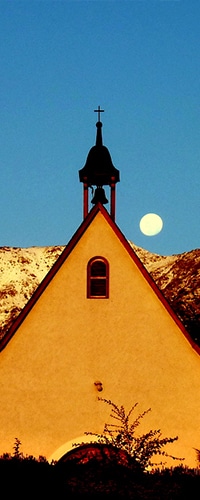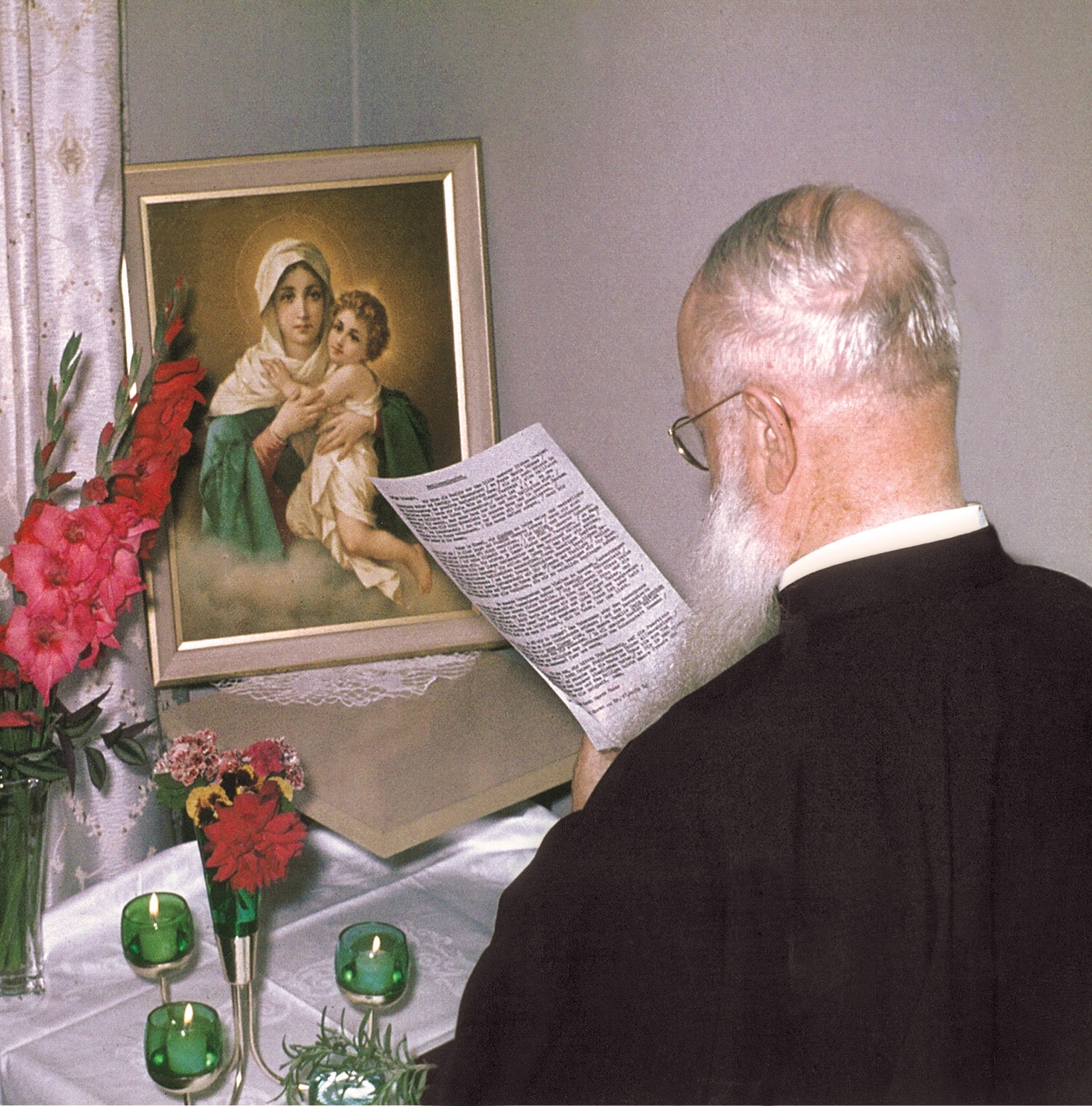Shrine network
Long before fast food chains like McDonalds discovered the cultural effect of totally identical establishments,the Holy Spirit in Schoenstatt began to do so.
The Schoenstatt Movement originates in a small chapel in the Schoenstatt Valley in Vallendar.
On October 18, 1914, Father Kentenich and students from the local Pallottine High School asked the Blessed Mother to become active from here as an educator of people who, in the power of Christ, shape the new times.
People experience Schoenstatt in their own country.
J. Kentenich
Nobody, not even Father Kentenich himself, could have known what would happen to this small beginning: Today, there is not only this first Shrine, the so-called “Original Shrine.”

About 200 shrines have been built in 35 countries on all continents, all exact replicas of the Original Shrine. Long before fast food chains like McDonald’s discovered the cultural effect of totally identical establishments, the Holy Spirit in Schoenstatt began to do so. It was during the Second World War. German Sisters of Mary, who built up the Schoenstatt Movement in Uruguay, felt that Schoenstatt could not be authentically transmitted without experiencing the shrine. They rebuilt the Original Shrine from memory and experienced the same gifts of grace as there. The example quickly became an example, and wherever Schoenstatt was founded, shrines were built.

Through the Schoenstatt Shrine, we are united as an international Movement in the center. At the same time, Schoenstatt can be experienced by people in their own country. The national shrines give the respective people an original rootedness in the Schoenstatt mystery. “People experience Schoenstatt in their own country” (J. Kentenich). This enables a new kind of “community formation” (J. Kentenich): Around each Schoenstatt Shrine, the regional Schoenstatt Family gathers in its many different communities and initiatives.
Daughter Shrines
With the birth of the “Daughter Shrines,” the Holy Spirit’s strategy did not end: at the beginning of the sixties, the so-called Home Shrines were born. As the Church began in the hearts, in the houses of the first Christians, the new Church should come into existence. Meanwhile, Home Shrines forms an extensive network connecting people of all ages, families, and individuals worldwide.
The number of people connected to the Shrine through the Pilgrim Mother, the Pilgrim Shrine, has risen to millions: the image of grace of Schoenstatt travels at regular intervals in a circle of individuals or families. It is estimated that about 15 million people worldwide are involved in this ”network.” Many of them have found faith through this network.
What began 100 years ago in a tiny way has expanded impressively. As early as 1951, Father Kentenich said that from the Schoenstatt Shrines, there should be “an international wave that crosses all peoples and nations” that “brings about a profound renewal movement” based on fundamental Christian values.
Who authorizes the construction of a daughter shrine?
Because the daughter shrines are so central to the life of the Schoenstatt Movement, their construction is subject to criteria that guarantee they will be vibrant places of grace in the long term and not falter after a few years. The responsibility for this decision ultimately rests with the national or regional presidium (è 157), which reviews proposals for building daughter shrines.
The most important criteria for building a daughter shrine are a large and vibrant Schoenstatt Movement, an appropriate piece of land, the necessary finances, a concept for a training center or meeting rooms, the support of one of the Schoenstatt Institutes, and the approval of the local bishop. In addition, one should have a pastoral concept for maintaining and promoting the Shrine, including questions like: Who will receive and accompany the visitors? How will the formation activity at the Shrine be coordinated and inspired? Who will take care of the buildings and grounds?


Home Shrines
What is a Home Shrine?
The home shrine is the place in the home where we receive the graces of the Shrine in a special way. The shrine in “domestic” form. Usually consisting of other symbols (such as a picture of Fr. Kentenich, of the Shrine, personal symbols, etc.), the home shrine is the place in the home where the graces of the Shrine are localized peculiarly.
The origin of the home shrine has its roots in the Schoenstatt work with families who instinctively wanted a “Schoenstatt corner” in their home. In 1962-63, while Fr. Kentenich was in Milwaukee, families who felt intense helplessness in raising their children Catholic raised the question of whether their homes could become shrines. The result was the development of the home shrine as a form of Schoenstatt Shrine. The first home shrines were blessed by Fr. Kentenich, who took a great interest in this new form of activity of the MTA in the family.
The home shrine is a place of prayer and spiritual encounter for the family at home. If a family is interested in having a home shrine, they usually work their way into the covenant of love and then prepare their home to be a shrine of the MTA. This preparation eventually leads to the dedication of the home shrine, which a priest performs and blesses the home. Traditions associated with the commitment of the home shrine are giving it a name and having each member choose a personal symbol to represent him- or herself in the home shrine; the family members present these symbols at the time of the home shrine dedication.
A home shrine can also develop its unique life, including life streams or symbols. The MTA picture can be crowned, and symbols of one’s Schoenstatt group or particular family customs can revolve around the use of the home shrine. These can help foster the atmosphere of prayer in a family or promote the sense that everyone has a place in this particular corner dedicated to God and the MTA. In that sense, it is a marvelous manifestation of the “domestic church.”
See CCC 1655-1658 (domestic church)

The heart Shrine
The dedication of the heart shrine can be implicit or explicit. It occurs when we make the covenant of love with the MTA, for we then join personally with the stream of life and graces from the Shrine.

It may also take place explicitly as an act of dedication in its own right, such as various families and lay people who did so in the presence of Fr. Kentenich in his last months in Milwaukee in 1965. This act can be inspired by a time of growing appreciation for Mary’s action in one’s heart as a shrine, by a time of heartfelt need to invite her explicitly to dwell there, or by a time of other spiritual growth, usually involving the unique character of one’s heart and mission.
The heart shrine is the dwelling of the MTA in one’s heart with the same graces as the Original Shrine through our connection to Schoenstatt’s covenant of love. Through the baptismal covenant, we come to share in the life of grace, which makes us a dwelling place of God and a temple of the Holy Spirit (see Rom 5,5 and 1 Cor 3,16). Because the covenant of love is a Marian form of renewal of the baptismal covenant, it also gives us new meaning and vitality as persons dedicated to God.

Wayside chapels
Wayside chapels can range in size from simple roadside or garden markers to small chapels. The smaller versions often express the desire of a person, family or group to make the MTA more visible in their neighborhood or area. They remind visitors and passers-by of God and prayer. Larger wayside shrines often serve as local centers for clusters of groups or a local Schoenstatt Family without a replica daughter shrine. Such a shrine (it may be a small chapel with an MTA picture, or an MTA picture at a side altar in a parish church) acts as the place of spiritual unity and attachment and if often the gathering place for meetings and the monthly commemoration of the 18th as Covenant Day.
"MTA chapels"
“MTA Chapels” are chapels with a special history dating to the years before the daughter shrines. In this time the desire to have a local shrine did not yet come together with the idea of building an exact replica. Instead, some other chapel was acquired or built, and an MTA picture installed. For the local Schoenstatt Family, the graces of the shrine are associated with this MTA Shrine, and some have since installed replica altars, but maintain the unique exterior form. Most are found in Germany and Switzerland.

































